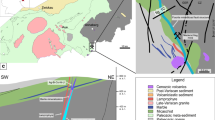Abstract
Several F, Pb, Zn and Ba deposits are located in the province of Zaghouan in north-eastern Tunisia. They are hosted in Lower Liassic or Upper Jurassic reef limestones, and the overlying condensed Carixian phosphatic limestones and Campanian marls, respectively. The mineralization occurs in three types of orebodies: stratiform replacement heaps and lenses (Jebel Stah and Hammam Zriba), breccia fillings and dissolution void fillings (Sidi Taya) and lodes (Jebel Oust). More than one generation of fluorite is observed in the stratiform deposits. Microthermometric analyses of the inclusion fluids observed in fluorite and quartz show that the economic concentrations of fluorite have deposited from moderate to highly saline (12–22.5 wt% NaCl equivalents) hydrothermal (110–160 °C) mineralizing fluids at the center (Jebel Stah, Sidi Taya) and to the east of the province (Hammam Zriba). Late remobilizations, observed in the stratiform deposits, are related to the circulation of a warmer (up to 185 °C) but less saline (10 wt% NaCl equivalents) fluid (Jebel Stah) and more saline (12–22 wt% NaCl equivalents) fluid (Hammam Zriba). The highest temperature (up to 250 °C) and salinity (32–34 wt% NaCl equivalents) are observed to the west of the province of Zaghouan (Jebel Oust). Less saline (3–6 wt% NaCl equivalents) and moderately hot to hot fluids (up to 220 ± 20 °C) and rich in gaseous CO2 invade most of the ore deposits in later stages and give rise to the massive quartz within fractures at Jebel Stah. Chemical analyses of the fluids extracted from the inclusions occuring in fluorite show compositions dominated by the presence of Na+, Ca2+ and Cl− ionic species and allow the mean temperature of the fluids in the source reservoir to be estimated as 275 ± 25 °C. The circulation of the ore-forming fluids is triggered by a regional tectonic extensional phase which occurs within the post-Jurassic to ante-Miocene time interval. The deposition of the economic concentrations of fluorite resulted from the decrease in pressure and temperature of the hydrothermal brines (Jebel Oust), along with the increase in the dissolved calcium activity (Jebel Stah and Sidi Taya), or a decrease in salinity due to the mixing with a hot, less saline and Na-poor, Ca-rich fluid (Hammam Zriba). The mineralogical associations (CaF2, PbS, ZnS, BaSO4) hosted within carbonate rocks, the temperatures and the salinities of the fluids that gave rise to the more important ore deposits (110–160 °C and 12–22.5 wt% NaCl equivalents), their composition (Na, Ca, Cl) and the molar ratios between the major ionic species, as well as the presence of liquid hydrocarbons in the mineralizing fluids, show that the ore deposits of the province of Zaghouan belong to the carbonate-hosted F, Pb, Zn, Ba Mississippi Valley-type deposits.
Similar content being viewed by others
Author information
Authors and Affiliations
Additional information
Received: 23 June 1995 / Accepted: 18 November 1996
Rights and permissions
About this article
Cite this article
Souissi, F., Dandurand, J. & Fortuné, J. Thermal and chemical evolution of fluids during fluorite deposition in the Zaghouan province, north-eastern Tunisia. Mineral. Deposita 32, 257–270 (1997). https://doi.org/10.1007/s001260050091
Issue Date:
DOI: https://doi.org/10.1007/s001260050091




